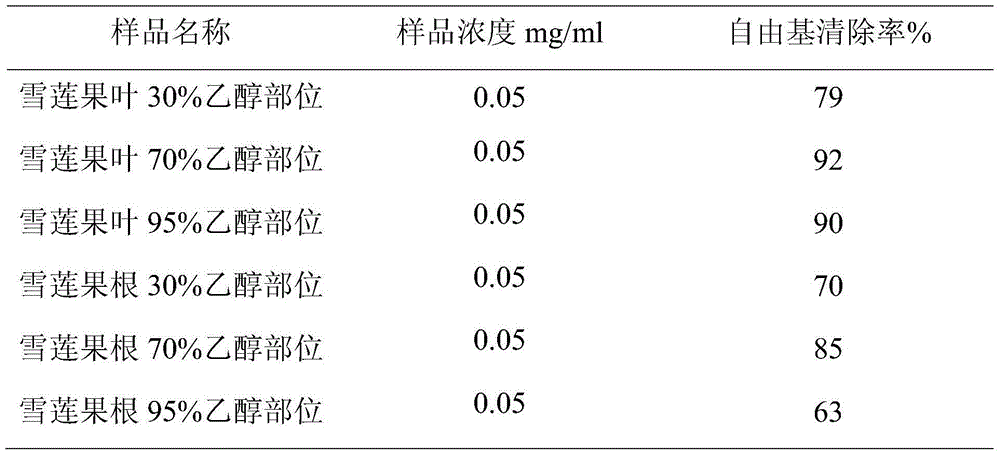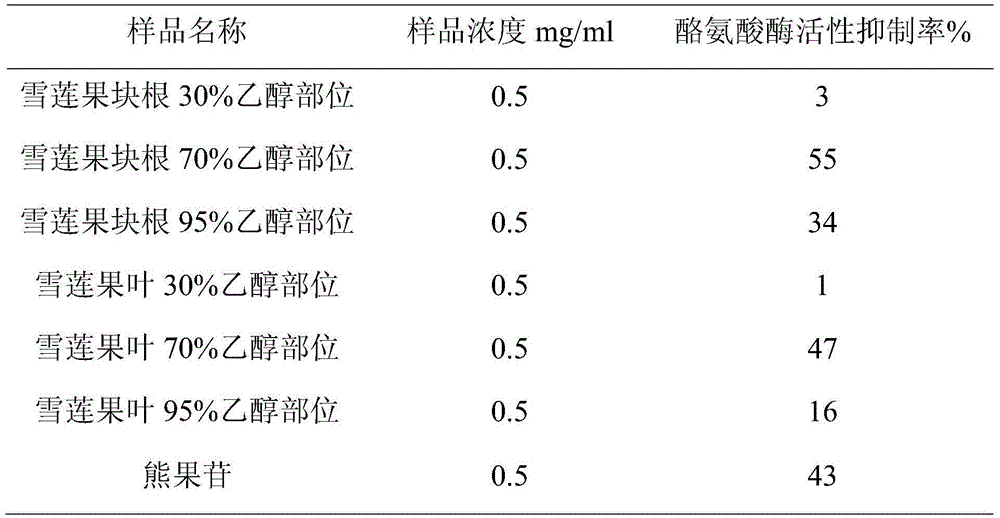Method for extracting smallanthus sonchifolius plant extract, extract and application
A plant extract and extraction method technology, applied in the field of yacon plant extract, can solve the problems of limited use, unsatisfactory whitening effect, stable skin irritation formula, etc., and achieve the effect of strong practicability and broad market prospects
- Summary
- Abstract
- Description
- Claims
- Application Information
AI Technical Summary
Problems solved by technology
Method used
Image
Examples
Embodiment 1
[0027] Embodiment 1: the preparation of yacon extract
[0028] Yacon leaves or tubers produced in Yunnan are used in this embodiment, but not limited thereto. In addition, the percentages mentioned in the examples all represent mass percentage concentrations unless otherwise specified.
[0029] (1) Add 1000 mL of 70% ethanol to 100 g of yacon leaves, ultrasonicate at room temperature for 1 hour, extract twice, and then filter. Concentrate the solvent of the filtrate to 50ml under reduced pressure, put it on the AB-8 resin column, and use deionized water, 30% ethanol, 70% ethanol and 95% ethanol to elute (each 500ml) successively, collect and remove the solvent under reduced pressure after collecting respectively, The dried solid was obtained and weighed to obtain 2.95 g of the 30% ethanol part of the yacon leaf, 9.89 g of the 70% ethanol part, and 2.45 g of the 95% ethanol part.
[0030] (2) Add 1000 mL of 70% ethanol to 100 g of yacon root, ultrasonicate at room temperature...
Embodiment 2
[0031] Embodiment 2: the detection of antioxidant activity
[0032]The yacon extract was prepared according to Example 1, and its free radical scavenging activity was measured by the DPPH method. The determination steps are: the yacon extract is prepared into an aqueous solution (mass volume concentration: 0.05 mg / mL) with deionized water, pipette 2 mL into a 10 mL stoppered test tube, and add 2 mL of DPPH (1,1-diphenyl -2-trinitrophenylhydrazine) ethanol solution (molar volume concentration is 2*10 -4 mol / L), mix well, let stand at room temperature, measure the absorbance T of 517nm wavelength with a spectrophotometer after 30min; measure the absorbance C after mixing 2mL DPPH solution and 2mL ethanol at the same time, the absorbance C after mixing 2mL deionized water and 2L ethanol Absorbance C 0 , and the absorbance T after mixing 2mL extract with 2mL ethanol solution 0 . Three parallel measurements were taken, the average value was taken, and the free radical scavengin...
Embodiment 3
[0037] Example 3: Detection of Elastase Inhibition
[0038] The yacon extracts prepared according to Example 1 were dissolved in deionized water to prepare an aqueous solution (mass volume concentration of 0.5 mg / ml) for the determination of elastase inhibitory activity. The assay steps are: add 10 μL sample solution and 130 μL containing 1.015 mM reaction substrate N-succinyl-propionamide-propionamide-propionamide-p-nitroaniline (English name Succ-Ala-Ala) to a 96-well plate -Ala-pNA, CAS number: 52299-14-6) in 0.1M Tris-Cl buffer solution (pH8.0), incubate at 25°C for 5 minutes, add 15μL elastase solution (0.5U / ml), continue Incubate at 25°C for 30min, then measure the absorbance A at 410nm wavelength with a microplate reader 410 . The sample aqueous solution was replaced with deionized water, and the absorbance was also measured as a reference solution, and the results are shown in Table 2.
[0039] The formula for calculating the inhibition rate of elastase activity is:...
PUM
 Login to View More
Login to View More Abstract
Description
Claims
Application Information
 Login to View More
Login to View More - R&D
- Intellectual Property
- Life Sciences
- Materials
- Tech Scout
- Unparalleled Data Quality
- Higher Quality Content
- 60% Fewer Hallucinations
Browse by: Latest US Patents, China's latest patents, Technical Efficacy Thesaurus, Application Domain, Technology Topic, Popular Technical Reports.
© 2025 PatSnap. All rights reserved.Legal|Privacy policy|Modern Slavery Act Transparency Statement|Sitemap|About US| Contact US: help@patsnap.com



